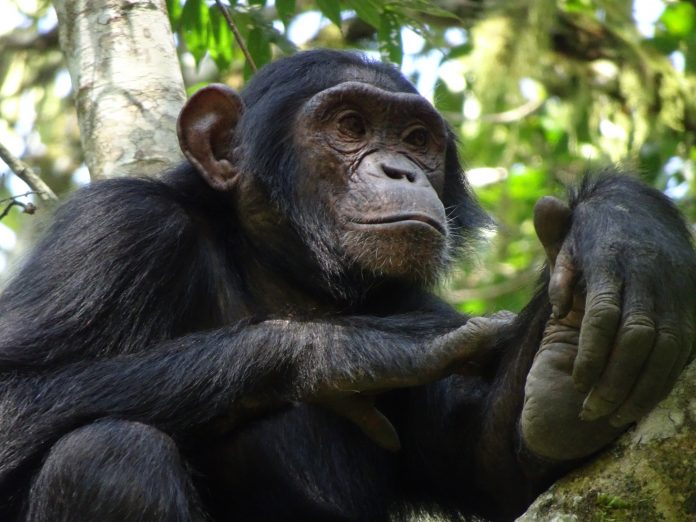What exactly do you think you know about the chimpanzees? We bring you the best of what you might know or ought to know about the chimpanzees in Uganda. The chimpanzee is a species of great apes found in the forests and savannah of tropical Africa. The Chimpanzees, man’s closest relatives are regarded as an Endangered species on the International Union for Conservation of Nature (IUCN) Red List.
Why are Chimpanzees regarded as man’s closest relatives?
The Chimpanzee or as commonly known the Chimp weighs between 40-70Kg for males and 25-50Kg for females and standing up to the height of 150cm. The chimps like humans live is groups of between 15 to 150 members, having a strict male dominated hierarchy. This can be related to the chiefdoms that we had a long time ago where disputes are solved without the need of violence.
Aside from the above, the gestation period for a chimpanzee is eight months, well the one for humans is nine months but we have seen loads of babies born in the eight months bracket.
For humans, the baby is breastfed for about two years that is recommended by the health practitioners however, the chimpanzee’s infant is weaned for about three years and maintains a close relationship with the mother for many years to come. The difference I notice here is that there is little mention of the father unlike in humans where the father figure is distinct to a particular female, the dominant male in the chimp family can be responsible for all the pregnancies in that family.
The chimpanzees have been noticed for their ability to use tools in search for food and hunting. Take an example of the Ngamba Island Chimpanzee Sanctuary on Lake Victoria, they introduced a termite mount and Chimps are often seen using sticks trying to dig out the termites. In the wild, chimpanzees have been recorded creating sharpened sticks to spear small mammals.
The bodies of a chimp is covered by coarse hair with the exception of the face, toes, fingers, soles of the feet and palms of the hands. Unless you need a much more explanation on this evidence however, the best way to find out with regards to this is by taking a good look at yourself!
The hair of the chimps is generally black, and as they grow old, white or grey patches appear. Since these creatures are native to the tropical Africa, this clearly has a close characteristic in terms of the hair of the native population who grow grey hair when they get old and a common notion signifying the grey hair is that it comes along with wisdom.
The chimpanzee eats about almost everything that we eat. Their most preferred though is a fruit diet. The chimps eat leaves, leaf buds, seed, stems, barks among others. Chimpanzee are mostly herbivorous however, they can also eat honey, insects, soil, birds, eggs, and above all small to medium sized mammals, including other primates. Several studies conducted establish that female chimpanzees tend to consume much less animal flesh than their male counterparts which brings back an old traditional belief where women were not meant to eat chicken especially among the Baganda.
Where are the Chimps found in Uganda?
Chimps are regarded to be natives of the savannah and forests in the tropical Africa. In Uganda, chimpanzees are predominantly found in forested areas. The most notable places where chimpanzees are found include but not limited to; Kibale Forest, Kyambura Gorge of Queen Elizabeth National Park, Bwindi Impenetrable Forest, Semlike Wildlife Reserve, Budongo Forest in Murchison Falls national Park in the wild and Ngamba Island Chimpanzee Sanctuary as well as Uganda Wildlife Education Centre in sanctuaries.
Visiting the Chimpanzee in Uganda
Chimpanzees in Uganda can either be visited in their natural habitants in the wild or in the sanctuaries.
In the sanctuaries, the chimpanzees can be viewed at Uganda Wildlife Education Centre (UWEC) in Entebbe where you would only have to pay for an entrance fee of about $15 to enter and view the chimps on top of other wildlife found at the center. At UWEC, you can as well get much more involved with the chimps by engaging in their activity called the Chimpanzee Close Up at a cost of $290, you get up close with the Chimps, this activity starts in the morning at 7am and lasts for about one hour. Be sure to go through some inoculations before you are allowed to engage in this activity.
Still in Entebbe, you can visit the chimps on Ngamba Island Chimpanzee Sanctuary, here the cost ranges between $80 to $250, depending on the number of people scheduled to visit the chimps on the Island. The more the number, the less the cost. Reason being, you take the boat from Entebbe to the island and there is always a minimum number that a boat is meant to operate. The major activities here would be heading to the island and view one of the feeding times for the chimps, this can be either in the morning departing at 0900hrs or in the afternoon departing at 1300hrs.
Then the most revered visiting of the chimps is in the protected areas of Uganda which include; Kibale Forest with a guarantee rate of 98% chances to see the chimps, then Budongo Forest, Kyambura Gorge, and Semliki Wildlife Reserve all of which carry a 50% chance of viewing. The Uganda Wildlife Authority tariff sheet has details of the fee to be paid at each park to visit the chimps.
Booking for a chimp trek in Uganda
In case you have booked your holiday through a tour operator, you need not to do much more than asking them to book for you a chimp trek permit on a specified that that you will be visiting that particular park and once you get to Uganda, all your permits will be at hand with your tout guide while you proceed on your trip. However, in case you are on a Self Drive in Uganda, you might have to ask your car rental company to arrange for your chimp permits beforehand and when once you arrive in Uganda as they are delivering the car to you, your chimp permits should also be delivered then you head off to start your trip. Otherwise the last resort would be to try your luck at the park headquarters the day before the trek to see if there are any spots available on the day although we strongly advise against this.






